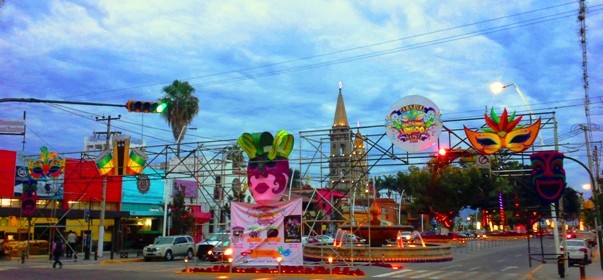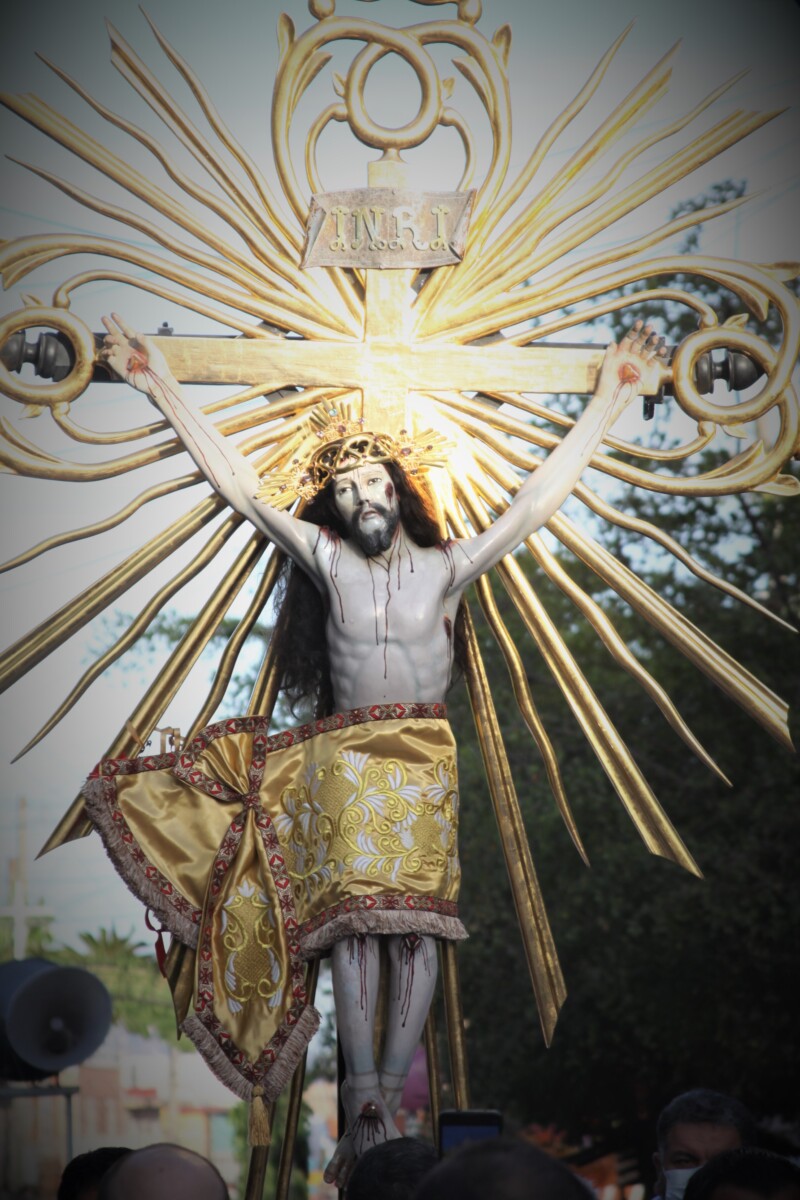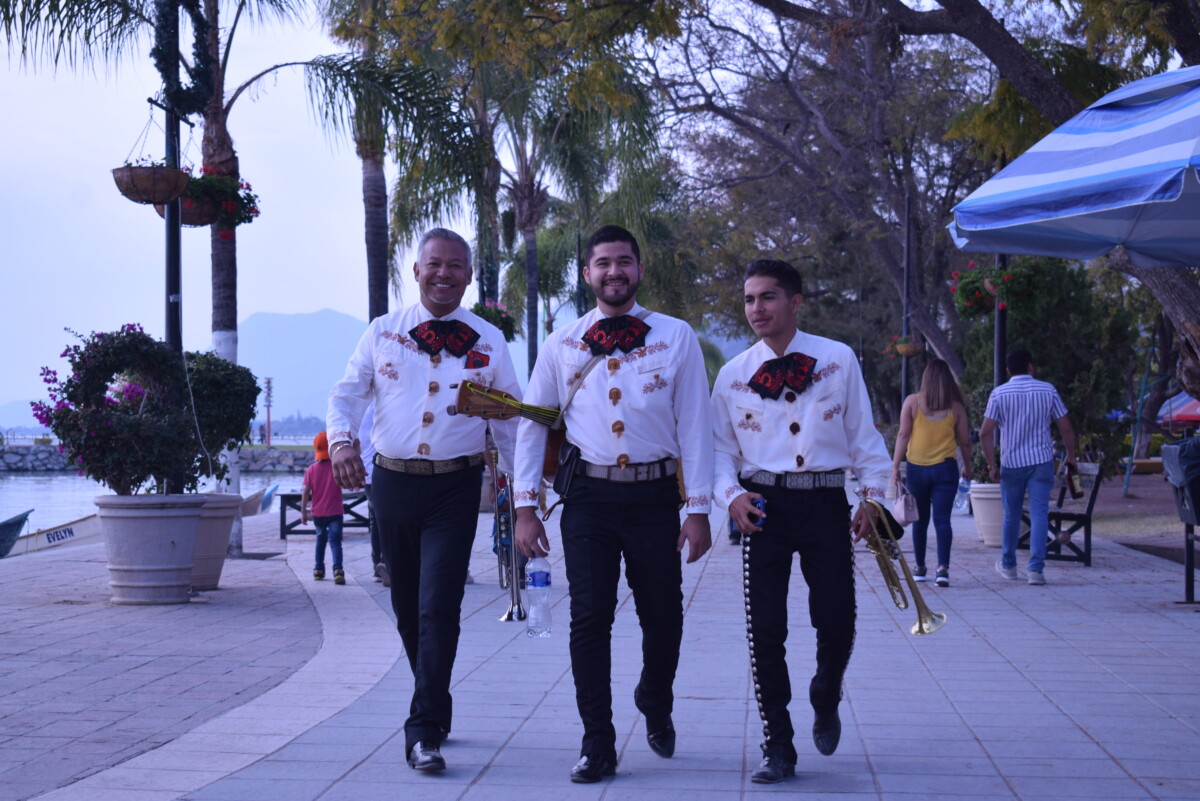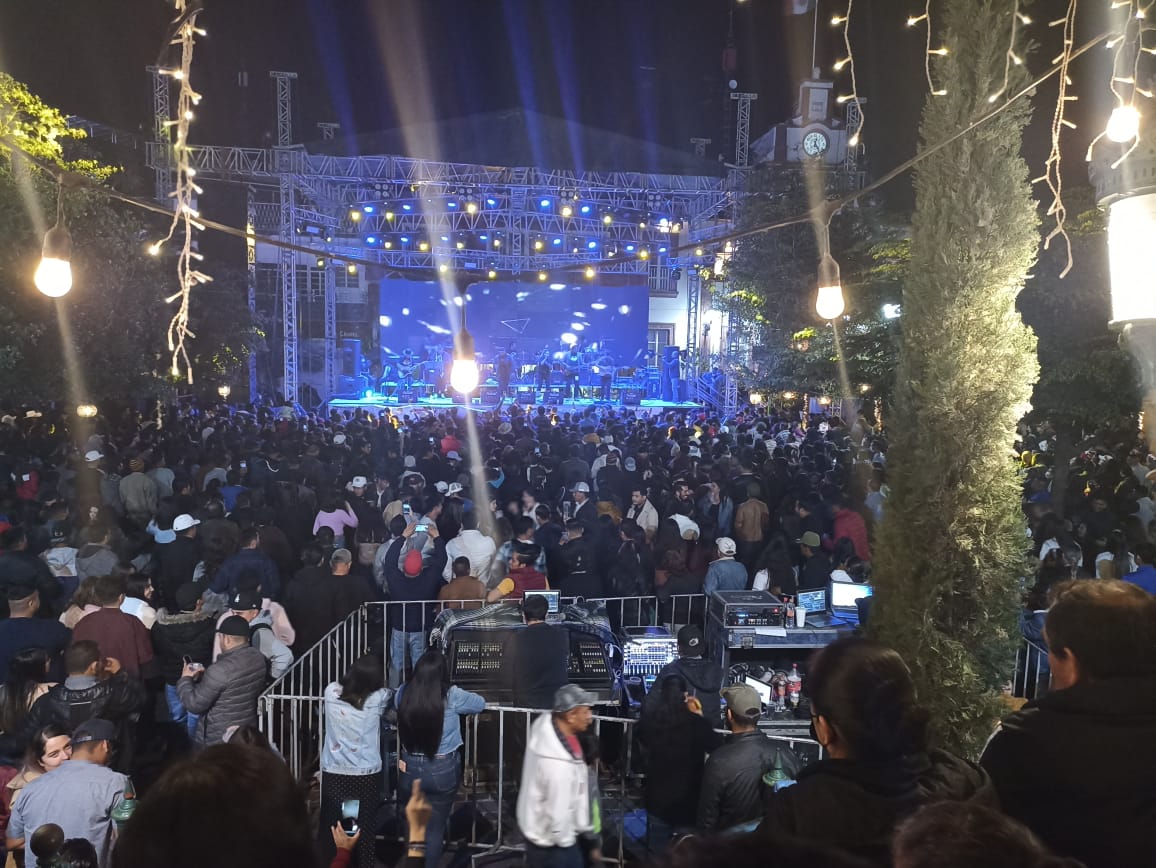eventos
OPINIÓN: DE NORTE A SUR
La Reforma Energética impulsada por AMLO busca favorecer a las plantas estatales de generación eléctrica. Foto: cortesía.
Por: Abigail A. Correa Cisneros
El nuevo régimen que propone el Gobierno Federal en su Reforma Energética estaría impulsando el crecimiento del campo y garantizaría la seguridad alimentaria nacional. Así lo considera el subsecretario de Autosuficiencia Alimentaria de la Secretaría de Agricultura y Desarrollo Rural, Víctor Suárez Carrera.
Desde su punto de vista, la aprobación de esta iniciativa es crucial si se quiere eliminar las desigualdades entre el campo y la ciudad o entre regiones y tipos de productores del campo. El funcionario encabezó la conferencia 32 del ciclo Autosuficiencia Alimentaria e Innovación Tecnológica con Prácticas Sustentables, que organiza la Secretaría de Agricultura.
En la conferencia, cuyo tema fue “Reforma eléctrica y sus implicaciones en el medio rural”, Víctor Suárez consideró clave que se impulse la confiabilidad del sistema eléctrico nacional como un sistema de servicio público nacional, ya que la planeación y control quedaría a cargo de la Comisión Federal de Electricidad (CFE), y también la soberanía nacional en minerales estratégicos, “pues concibe que el litio y otros minerales serán bienes del dominio de la nación de manera inalienable e imprescriptible”.
El director general de la Comisión Federal de Electricidad, Manuel Bartlett Díaz, afirmó que la reforma eléctrica que impulsa el Ejecutivo federal no representa de ninguna manera una expropiación para aquellos que hoy desde conglomerados privados ofertan ya el 46 por ciento de la energía en el país.
“Ese 46 por ciento es negocio, representa un mercado más grande que el de toda Argentina y Venezuela. No hay expropiación. Se les invita a que participen en un sistema de competencia entre ellos y bajo control y regulación del gobierno mexicano; pueden crecer o invertir, pero bajo el control de gobierno, pues la electricidad en conjunto se convertirá en un sistema de interés público”, afirmó.
El gobierno ha destacado, con la finalidad de que se apruebe la reforma, que hay un saqueo a Nación, permitido y gestado desde el salinismo, cuando comenzaron a impulsar las sociedades de autoabasto y los generadores independientes, mismos que se fortalecieron con la reforma de 2013. De esta forma se indujo la privatización de actividades que eran exclusivas del Estado, es decir, la transmisión, distribución y entrega de la electricidad.
El gobierno actual busca poner fin a estos abusos, sostienen las autoridades, porque se siguen otorgando beneficios ilimitados al sector privado, con fórmulas de abasto de energía que han puesto en desventaja a la CFE, pues ésta no recibe de dichas figuras de inversión privada pago alguno por el uso de su infraestructura de transmisión –una infraestructura pagada por recurso público durante décadas– y además la Comisión debe solventar las intermitencias diarias en dicho abasto de privados, lo cual merma económicamente a la paraestatal.
De seguir así, la CFE está condenada a la extinción, aseguró su director general; y en manos privadas -fundamentalmente de empresas como Ibedrola, otras italianas, así como fondos de inversión internacionales cuya cara no es visible- lo que ocurrirá será que la inversión en energía se concentre en los espacios territoriales que resulten de interés de negocios, como grandes ciudades, y se abandone a las localidades rurales, generando una mayor desigualdad social en México y también una desigualdad entre los agentes del medio rural.
En cuanto a la explotación del litio, México cuenta con una riqueza de 1.7 millones de toneladas, y con ello ocupa el lugar número 10 entre los países líderes globales en este mineral, mismo que encabeza, junto con el grafito y el cobalto, la lista de los 17 minerales que el Banco Mundial cataloga estratégicos para la transición energética necesaria para afrontar el cambio climático.
Sin embargo, es un tema en el que hay que profundizar, pues la explotación de este mineral en otros países ha representado la aniquilación del ecosistema. Aunque el gobierno de Andrés Manuel López Obrador asegura que no se realizarán expropiaciones y que la misma reforma pondrá freno al saqueo minero histórico en las últimas tres décadas.
Argumentan que la extracción de litio favorecería las acciones contra el cambio climático, al ser un mineral utilizado en autos eléctricos. Se prevé que en 2028 la presencia de estos vehículos, catalogados como una mercancía fundamental para la transición energética, pasará a ser de entre 50 y 200 millones de autos y para 2040 alcanzarán hasta 900 millones.
De allí que el litio tienda a encarecerse agudamente y resulte estratégico para los 23 países del mundo que cuentan con esta riqueza mineral. Actualmente una tonelada de carbonato de litio se vende en China en 41 mil 60 dólares, cinco veces más que lo observado hace un año.
Pero la extracción es peligrosa. En algunas zonas de México donde ya se realiza se pieza que habrá litio hasta dos décadas, durante las que se podría contaminar mantos acuíferos y acabar con la flora y fauna del lugar.
Es importante considerar que se utilizarán enormes cantidades de agua, de la que México ya no puede destinar a estas actividades porque el líquido escasea. Otro punto para analizar es el impacto a la salud ambiental. El cuerpo humano tiene alrededor de 7 miligramos de litio y a partir de 15 ya es altamente tóxico, por lo que, si se llegan a contaminar los mantos acuíferos o los ríos, ese litio puede llegar a las comunidades que quedarían expuestas a envenenamiento.
DESDE EL CENTRO
La Red de Bancos de Alimentos de México (Red BAMX) destacó que el desperdicio de alimentos también afecta el uso de agua. Se estima que 34 por ciento de los alimentos que se producen en México se desechan y el volumen de agua utilizada en estos sería suficiente para abastecer a la población mexicana durante 2.4 años. Mientras en el país hay 28.6 millones de mexicanos que viven en inseguridad alimentaria. En México se desperdician 20.4 millones de toneladas que equivalen a 491 mil millones de pesos. En 2020 un estudio indica que de 79 alimentos de la canasta básica se pierden 23.7 millones de toneladas, lo cual representa 2 por ciento del PIB.… Este dos de febrero, día de la Candelaria, faltarán tamales en algunas casas y oficinas. Vendedores reportaron la baja venta por el aumento de materias como las hojas de maíz, la manteca, pollo, queso, mole, la mayoría de los productos que se utilizan para preparar este típico antojito mexicano. También la pandemia provocó que este año los pedidos fueran menos, al haber poca afluencia en oficinas.
Requested approval from the Jalisco Health Board to hold the Chapala Carnaval
The last Carnaval celebrated in Lake Chapala was in 2020. Photo: Archive.
Jazmín Stengel. Despite the pandemic, the Mayor of Chapala Alejandro Aguirre Curiel has requested approval from the Jalisco Health Board to hold the Chapala Carnaval, beginning at the end of February and running through early March.
After a two year absence, the City Council has decided to grant planning of the Chapala Carnaval to individuals to organize the festivities this year. «The idea is that it will be done externally with support from the municipality,» municipal president Alejandro Aguirre said. He added that a group of people has expressed interest in taking on the responsibility.
While public gathering restrictions issued by the Health Board of Jalisco will remain valid until February 12, the Municipality of Chapala has applied for and is awaiting the necessary permit to hold the festivities. In this respect, Aguirre reflected: «we have to learn to live with it (Coronavirus), since we are all exposed.»
Translated by MaryAnne Marble
San Sebastián ceremony returns with lively religious celebrations
Entrance of the procession to the parish of San Andrés Apóstol, where the image of the saint was finally left
Sofía Medeles (Ajijic, Jal.)- Although San Sebastián was celebrated with a very modest ceremony, the neighbors of the neighborhood did not miss the opportunity to celebrate the saint with a mass in the neighborhood located in the north of Ajijic, sharing hot chocolate and bread, and in the afternoon, with a small procession to return the religious figure, enlivened with a musical group and the traditional masked sayacas.
«The celebration was good. It was a little smaller than other years, but it felt just as nice,» said one of the participants.
The January 20 mass was celebrated in the neighborhood of San Sebastian, as it is the one day of his feast.
During the morning, the mass was attended by no more than 50 people and all of them respected at all times the health protocols in force. At the end, chocolate, cinnamon and tachihual bread were distributed to the participants of the Eucharistic ceremony. «It was good, it was small, unlike other years, but it felt just as nice,» said Don Antonio, a close neighbor of the neighborhood.

The neighbors of the neighborhood did not miss the opportunity to celebrate the saint with a mass in the neighborhood located in the north of Ajijic.
Later, during the procession, more people -approximately 70 people- could be seen. The procession began with the sayacas dancing, while behind them was a musical group, and at the end, San Sebastian, carried by four men.
Throughout the procession there was a group of children looking to be chased and floured by the sayacas. The sayacas danced, while all around them spectators enjoying the festivities and filming the scene.
«This is what one likes. There have already been so many big celebrations, like the one in Jocotepec. I don’t think there will be a fuss about this. There are only neighbors here and we are all wearing our masks. We had the pleasure of being together and also sharing a beer,» said Don Nico, minutes before the procession began.

During the celebration, a couple of tourists joined the dance of the sayacas that accompanied San Sebastian on his route through some of the streets of Ajijic
Although the route changed a bit –through Zapata, Javier Mina, Guadalupe Victoria, a lap around the plaza, and finally Parroquia street—San Sebastian was accompanied by spectators all the way. In the plaza, a couple of excited tourists joined the procession to dance to the music of the band.
«We didn’t imagine there was going to be a parade, we just came to walk around because there was an opportunity. We didn’t know San Sebastián, much less imagine that here in the Pueblito Mágico he is so beloved,» mentioned a man who was sitting in the plaza.
In the end, only those carrying the image entered the parish of San Andrés Apóstol where the saint was taken, as well as a few companions, while the sayacas remained at the entrance of the parish, and the band played the mañanitas outside the temple. After leaving him, the people returned to the neighborhood of San Sebastian, located to the north of Ajijic.
Translated by Sydney Metrick
Lakeside Chronicles
The Señor del Monte religious festival has filled the streets of Jocotepec for more than 180 years on the third Sunday of January.
By María del Refugio Reynozo Medina
That time long ago, we could not even reach the threshold of the parish; Juan Pablo and I got lost in the human tide that swirled around the statue of the Señor del Monte. We were going against the current; after the rubbing of sweaty bodies in which we could even feel each other’s ribs, we returned to the little truck that had taken us there and was about to leave us. We could not see the Señor del Monte.
More than 20 years have passed since that day. Today, half an hour before the start of the procession, the atrium begins to receive the pilgrims who continue to arrive, but do not flood the enclosure. According to some parishioners, this year there was half the attendance compared to the years without the Covid-19 pandemic. Some five thousand people this year, according to data from the Civil Protection Office of the municipality of Jocotepec.
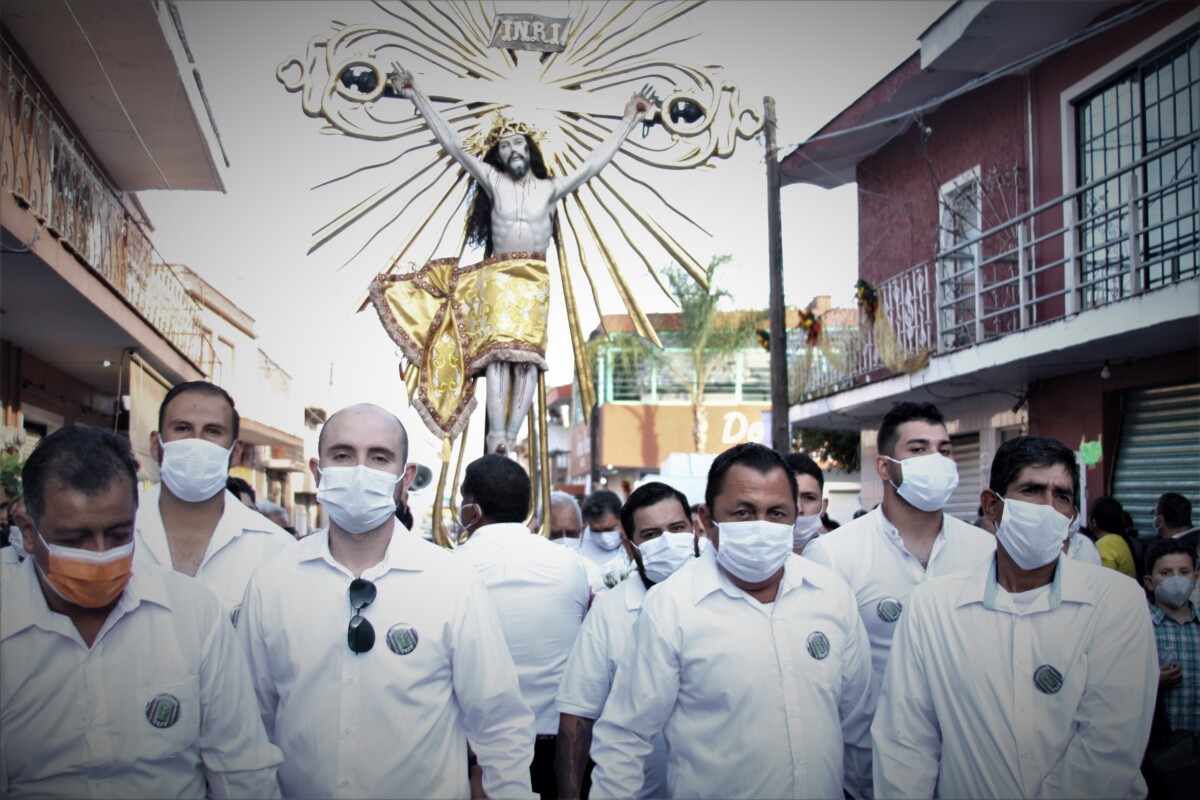
The positions of the honor guard are inherited from generation to generation to the firstborn.
In the temple, the members of the honor guard are already behind closed doors preparing the Señor del Monte for his journey, as has happened every third Sunday of January for more than 180 years.
The Jocotepec chronicler Manuel Flores Jiménez, marks the year 1834 as the first occasion that the ancestors celebrated his «miracle,» then November 8, 1833, as the date in which they also congregated, to swear in writing to take him as the patron saint of their lives. In 1918 the oath was renewed.
The honor guard is composed only of men, all direct descendants of those who took the original oath. There are about 150; most are adults, the youngest is 11 years old. They are grouped by families, each one with a specific task such as organization, preparation of the image for its journey and care and custody of the patron during the procession.
Belonging to the honor guard is a privilege that is inherited from generation to generation and becomes a gift that arrives by destiny.
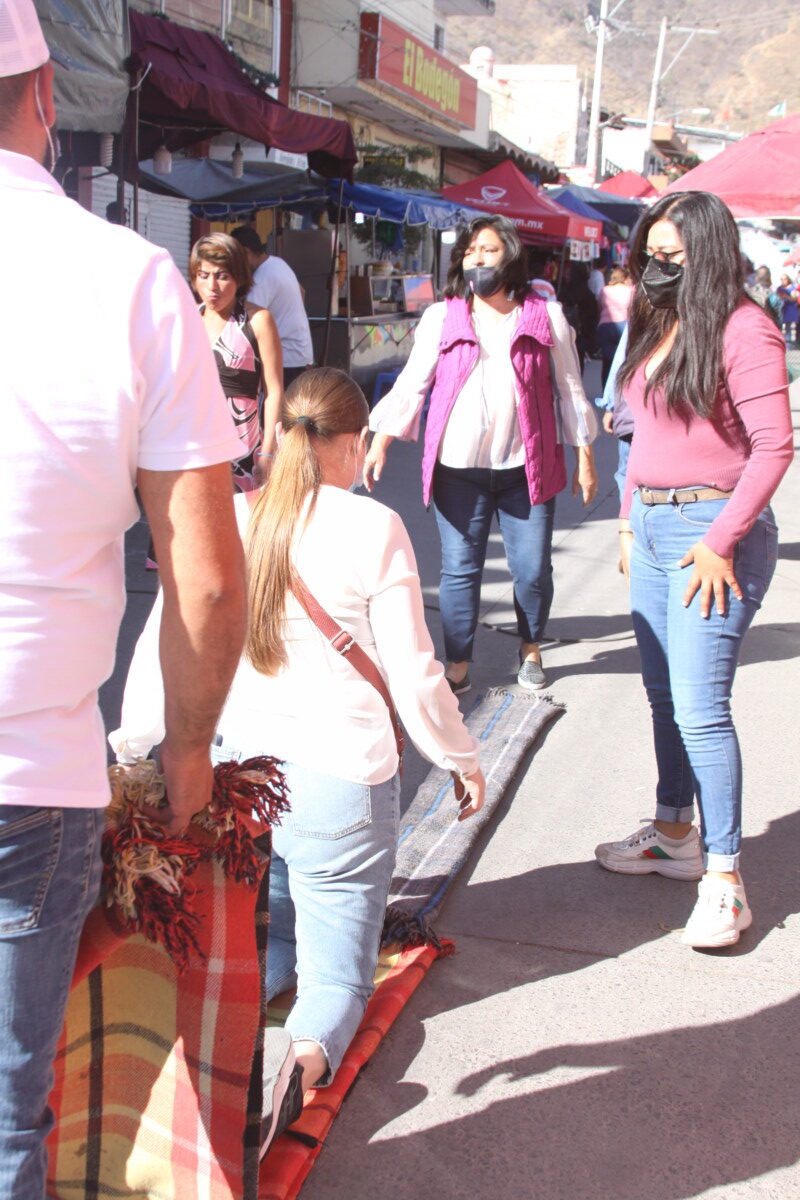
Some people advance to meet the procession kneeling to give thanks for favors received or to ask for help from the Señor del Monte.
The men of the honor guard are dressed in white shirts, surrounding the image that has already been taken down from the altar, and finish preparing it for its procession. There are few women in the place; not even ten, they are direct relatives of the members of the honor guard. It was not until about ten years ago that women were allowed to enter.
The Lord of the baptistery is already downstairs, as his ancestors called him before he became their official patron saint, according to the records of the chronicler Flores Jiménez.
The Christ directs his gaze to the sky with half-open lips, has a sharp nose, beard and black hair. He has his arms extended on the wooden cross that appears to shine; that cross «morena de sol» as father Benjamín Sánchez calls it in the Romancero de la vía dolorosa, is bordered with golden rays.
The Señor del Monte wears a coppery cloth with rich embroidery, and on his head, a splendorous crown made of prayers always heard, because «this Lord is very prodigious.»
“I am one of his miracles,» says Manuel Ibarra, who emerged victorious from a cancer diagnosis. Before going to the hospital, he prayed to the Señor del Monte for his health and touched the body of the Christ figure with a piece of absorbent cotton, to carry it with him in the battle against the disease. That was 12 years ago.
Jésus Pérez is the grandson of Cándido Pérez, the latter was present at that historic oath and appears in a painting, «The Oath» which is in the sacristy of the parish. Now Mr. Jésus participates with his son Óscar Pérez and his grandson Alejandro Pérez.
Minutes away from the beginning, the bells toll with a festive flavor, a human fence begins to form and dozens of eyes look anxiously at the huge wooden door.
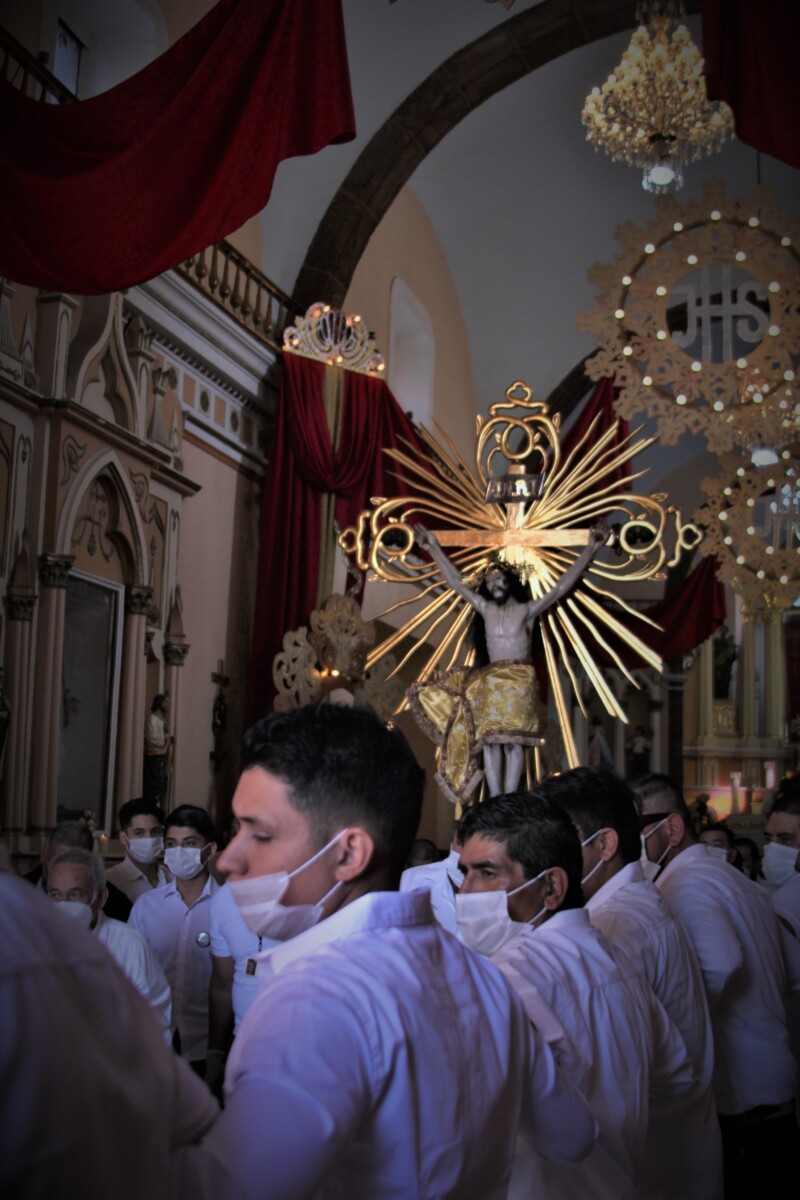
The men of the honor guard intertwine hands to leave the temple with the image at the beginning of the procession.
-Long live the Señor del Monte!» shouts a man’s voice, seconded by another female voice.
-Long live! ¡Viva!
The fervent voices respond and the door opens.
The faithful crowd moves to meet the crucified Christ. The drums of the dancers sound and the pilgrimage begins.
Leading the procession is a girl of about five years old dressed as a dancer, she emulates the steps of her elders and glides safely across the width of the street.
A man and a woman wear white t-shirts with «Danza por manda» written in black letters. With them are more people who dance throughout the procession in orderly rows. There is also the marching band, a young man on stilts who helps with the order of the walkers, and a mariachi band.
A female voice prays the rosary and sings over a loudspeaker from a cart.
Some streets are adorned with bows of red and yellow satin ribbon, also with arches of fresh flowers.
The Señor del Monte is carried by a guard of 20 men, one of them walks backwards, every so often along the way they are exchanged for another group of 20. Five guard changes are made along the pilgrimage, in total there are one hundred men who help carry the patron saint.
«Vivas!» to the Señor del Monte are heard along the route, tearful eyes seek the face of the crucified, there are many tears shed, many prayers in silence, which are announced by the tearful look of those who come out in their path.
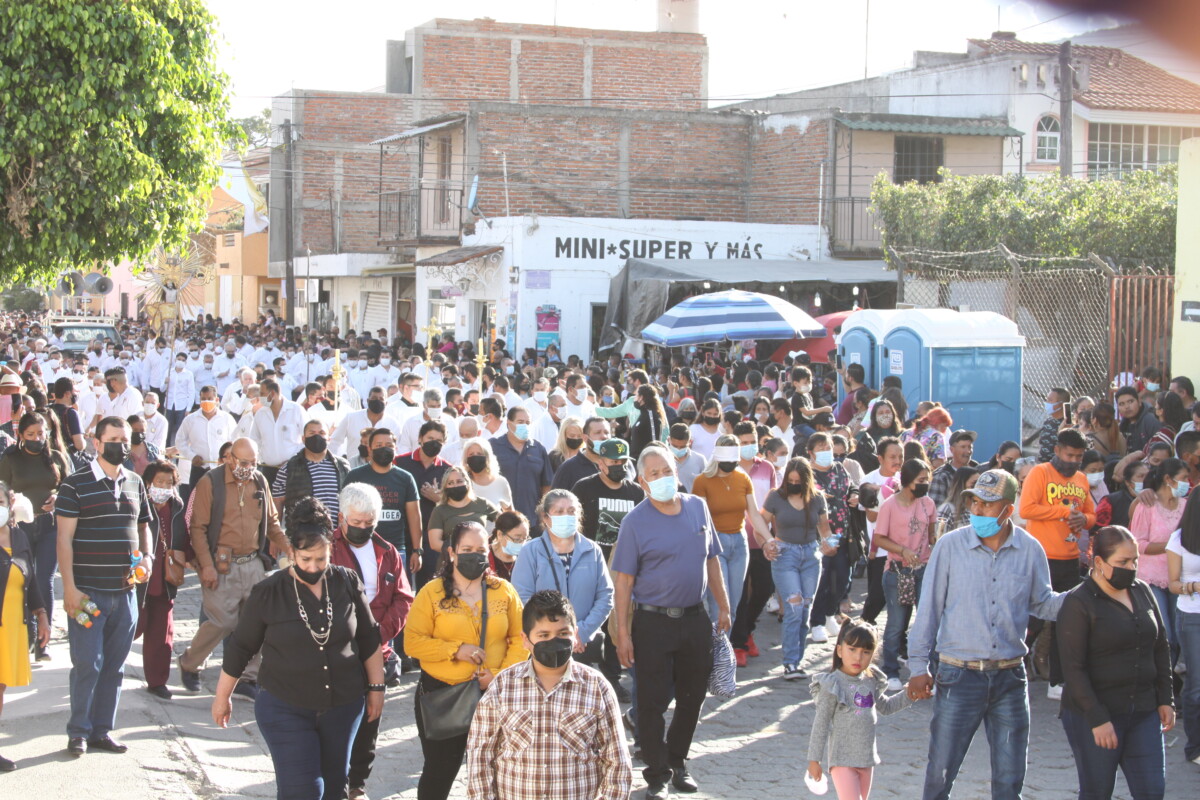
With the attendance of about five thousand people, according to data from the Civil Protection Department of Jocotepec, the procession in honor of the Señor del Monte took place.
Some people go barefoot and blindfolded; a line of men and women who advance kneeling in the opposite direction to the procession, go to meet the image, supported by folded blankets thrown on the floor.
Civil Protection officers watch over those who are kneeling and help them to get back up.
The khaki uniforms of the officers and their yellow helmets contrast with the brightly buttoned suits of the mariachis and the white shirts of the guardians of the faith.
The officers, the faithful, musicians, and priests all converge in an ancestral procession, dedicated to that ancient Lord of the baptistery who summons thousands because his presence radiates something indescribable.
Translated by Kerry Watson
Chapala Musicians’ Guild Reports Good Winter Season
Members of Mariachi Centenario de Chapala (from left to right): Eric Serna, Ramón Úlises and Brandom.
Jazmín Stengel, Ajijic (JAL)-At an informal meeting between Laguna Seminario and members of the Chapala Musicians’ Guild, the mariachi “Centenario de Chapala” group’s trumpet player, Eric Serna, said «It [this season] wasn’t the best, but it was better than last year.»
Among mariachi groups that work on the malecón and Chapala tourist area such as the groups “Centenario,” “Aguila,” and “Norteño Los Alacranes,” group members mentioned having earned up to a thousand pesos a day per person during the winter season. Each mariachi group charges 250 pesos per song to the general public. Groups usually consist of five to seven musicians. The good season began in November; however, during the holidays «we even get tired of working,» Serna added.
The situation in Chapala has improved to such an extent that Serna and his colleagues have preferred to remain in Chapala instead of traveling to Puerto Vallarta as they usually do during the low season. On the other hand, the soloists working in downtown Ajijic and the surrounding restaurants considered December as having been the lowest month of the season, although in January «people have been more splendid,» agreed three area guitarists. This was echoed by merchants of the Tianguis Navideño [merchants who sold their merchandise in Chapala’s plaza last holiday season], who complained about the low sales during the winter holidays for businesses of all sizes.
Translated by MaryAnne Marble
The Terranova Institute inaugurates the first school tennis court in Lakeside
The facilities were inaugurated in December with a ribbon cutting in which authorities from the Ministry of Education Jalisco, the City Hall and the educational institution itself participated.
Editor. – The Terranova Institute of Ajijic inaugurated the first tennis court in an educational institution on the shores of Lake Chapala with a religious mass, a ribbon cutting and a demonstration match played by its students.
The sports facilities were inaugurated during the month of December and will be used by students who decide to take up this sport as part of the optional subjects in their academic offerings.
During the inauguration the administrative director, Salvatore Blum, emphasized that with tennis the institution will now have five sports disciplines for the students, as part of the comprehensive education they receive so that they can achieve the best version of themselves through discipline, perseverance and teamwork.
The inauguration was attended by educational authorities from the Secretary of Education of Jalisco in the region, as well as representatives of the Chapala City Hall and benefactors of the educational institution, in addition to students and teachers of the school.
Translated by Patrick O’Heffernan
El Festival de La Michi se inaugurará el 20 de enero en La Cochera Cultural
Mariajose Medeles como La Michi en la película «La leyenda de Michi-Cihualli».
Patrick O’Heffernan . Ajijic (JAL)- El Centro Cultural de Arte y Cultura La Cochera Cultural en Ajijic, está produciendo un Festival de La Michi, de tres días de duración, con arte, danza, música y cine, dedicado a la leyenda de Michi-Cihualli, la “Diosa del Lago de Chapala”. El festival se celebrará desde el jueves 20 de enero al sábado 22 de enero, respetando el aforo y siguiendo todas las medidas de sanidad dictadas por la Mesa de Salud.
El maestro Antonio López Vega, comisario de La Cochera Cultural, ha organizado el festival en torno a la leyenda de Michi-Cihualli que le contó su abuela, utilizando conceptos artísticos en los que lleva años trabajando. En él se proyectarán en primicia el cortometraje experimental «La leyenda de Michi-Cihualli» y el documental «Al encuentro de la historia de Michi-Cihualli», además de la presentación de danza contemporánea y multimedia «Habitando Michi-Cihualli», junto con los Raperos de San Sebastián y mesas redondas con artistas, actores y activistas locales que trabajan para proteger el Lago y las montañas.
El festival es gratuito, en beneficios del grupo grupo Axixic Michicihualli y el Respaldo Alimentario de Juanacatlán. La Cochera Cultural se encuentra en calle Javier Mina #49, en Ajijic.
Te compartimos el programa general del festival:
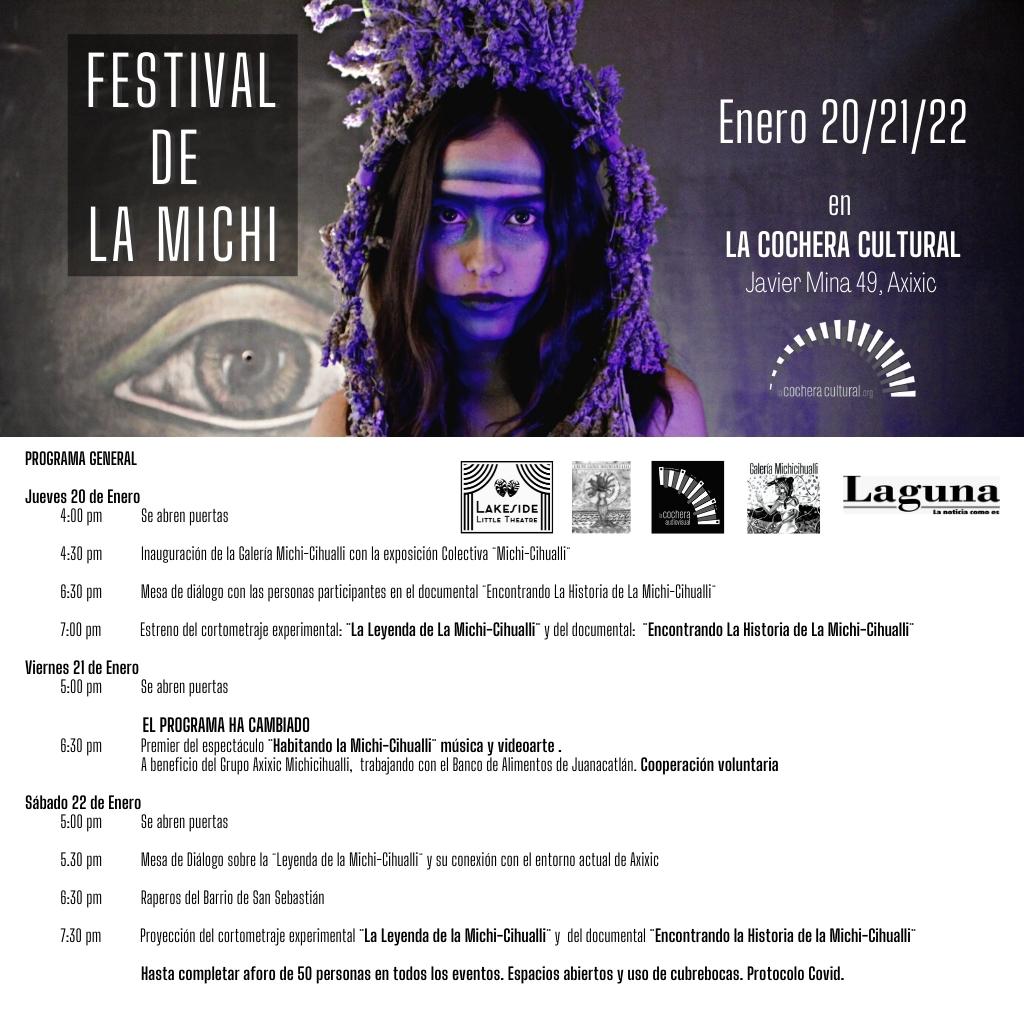
Ajijic locals say that the Coffee, Chocolate and Wine Festival was not affordable
The Coffee, Chocolate and Wine Festival was held on January 8 and 9 at the Ajijic Malecon.
Sofía Medeles (Ajijic, Jal.)– Although the «Coffee, Chocolate and Wine Festival» was well attended by tourists, the “Ajijitecos” or local residents didn’t like the event because they felt that this type of festival does not help local commerce and only benefits a few.
According to 14 locals interviewed at the festival held last weekend (January 8 and 9), it is the foreign merchants who are taking advantage of the Pueblo Mágico designation, which in fact doesn’t benefit local commerce, but rather harms it, in addition to the fact that the prices are too high for local people.
«They are only using the Pueblo Mágico designation to benefit a few, because not all of us produce the kind of things they sell at these festivals, and besides, they are expensive. Only tourists or Americans can afford to buy things from there. Many of us would like festivals that are really made for ajijitecos,» said Luis, who was present on the malecón with his family while the event was taking place.
The event, installed on the Ajijic boardwalk corridor, was attended by around 50 exhibitors, who competed with the merchants who set up shop on the boardwalk every weekend.
The street merchants interviewed pointed out that there was a lot of tourism, but sales did not go well, since the public concentrated on the festival, which offered a variety of products ranging from food and handicrafts to art pieces.
“Yes, there are a lot of people, but we’ve hardly sold anything. Look, those from the festival sell the same things I do, and that’s why I haven’t sold much,» complained one of the street merchants who set up shop in the handicraft corridor on one side of the Ajijic pier.
Ignacio, an Ajijic native, said that people don’t even come to browse, thinking that these are products they can’t afford to buy. «One prefers not to get involved in these things. Apart from the fact that there are always a lot of people who must crave these products, and I say crave, because when you ask, they tell you that a sandwich, a pair of flip-flops, or a sweet is more than 100 pesos. That’s very different, for example, from the sales that take place during the November holidays, where you know that you will be able to afford many things.”
A woman named Brenda García, originally from San Miguel de Allende, commented that something similar happens where she comes from, and stated that she believes that this happens in places where there is a lot of tourism. «What happens in Ajijic is a controversy that also happens in San Miguel de Allende, a tourist town in Guanajuato. Suddenly there are events that are focused more on tourism, or who can spend. The difference is that over there they are usually held in private places such as restaurants or vineyards, thus better targeting the public they want.”
Maximiliano «Max» Macias Arceo, in charge of the office of the Ajijic delegation, commented that one of the main problems that may cause these opinions are the high prices of the exhibitors, but that it’s not possible to compare products that companies manufacture to the handmade products.
«Between a product from an established company and one from an artisan there is no point of comparison. We understand that the prices they charge don’t suit us, but we must also consider that they come from distant places, such as Morelia, Yucatán, Oaxaca, Michoacán, and they have to cover those large expenses, so we can’t put conditions on their prices. Even so, I hope that in the future we can have more balanced events, so that we all have the opportunity to buy something we like.»
The Coffee, Chocolate and Wine Festival was born in Patzcuaro, Michoacan, a little over three years ago, and this year, for the first time, it is being held in Jalisco. The event brought exhibitors from various parts of the country – for example, Oaxaca, Mérida, Yucatán, Michoacán – and not only exhibited food, but also crafts and local art.
Translated by Sandy Britton and Patrick O’Heffernan
Coffee, Chocolate and Wine Festival lax with COVID-19 protection measures
During the day there was a large flow of attendees. Due to the constant offering of tests, not everyone wore a mask during their stay at the festival.
Sofía Medeles (Ajijic, Jal.)– In spite of assurances to the press prior to its opening, the Coffee, Chocolate and Wine Festival organizers failed to implement COVID-19 prevention protocols as they had planned.
At the pre-event press conference, event organizer Raúl Ceniceros proposed that event staff would limit and control the capacity of the crowd inside the tent by having only one entrance and one exit, and that they would take temperature checks and enforce the use of face masks for both attendees and exhibitors. However, none of these measures were fully instituted.

The inauguration of the festival was presided over by the mayor of Chapala, Alejandro Aguirre Curiel; the director of tourism, Paola de Watterlot; the head of the Ajijic delegation, Maximiliano Macías Arceo; the municipal trustee Gamaliel Soto Pérez; and the event organizer, Raúl Ceniceros.
The festival, held over two days (January 8 and 9) on the Ajijic boardwalk, was well attended and at times saw hundreds of people crowded together inside the tent. Neither exhibitors nor visitors were required to wear masks, and the public could enter at different points without using antibacterial gel or getting temperature checks. Furthermore, the constant sampling of products on offer at the event was a pretext for many not to use masks.
Event staff stationed at the designated «entrance» to the festival tent, shared that the only instructions they had been given were to ask people entering to wear their masks; to hand out sanitizing spray, and to take peoples’ temperature. They said that overall they had no major problems carrying out the safety measures, except with a few attendees who refused to comply.
From the perspective of exhibitors, however, the festival was a success. Several exhibitors interviewed stated that they are very grateful for events like these, as they provide increased exposure for their products and opportunities for sales at a time when such opportunities are scarce due to the pandemic.

The festival, held over two days (January 8 and 9) on the Ajijic boardwalk, was well attended and at times saw hundreds of people crowded together inside the tent.
«It went very well, we are delighted with the event, the first of this year,” commented an exhibitor from Do Perniler, marketers of Serrano and Iberian hams from Tequisquiapan, Querétaro. “People kept stopping by, everything was very pleasant, and everyone was open to trying our products. It went very well, and Ajijic is a wonderful place; we left very much in love.»
The event, in addition to having samples of food products and wines, also had art and handicrafts for sale. The sixty-six exhibitors included a number of local artisans, such as Luna Cacau.
The head of the Ajijic delegation, Maximiliano «Max» Macias Arceo, assured that while some might look unfavorably on the event due to the circumstances of the pandemic, there were no serious mishaps. He also commented that he viewed the event as positive, in keeping with the promoted theme and of good quality.
Translated by Rebecca Zittle
Jocotepec patron saint festivities continued despite new state mandate
An average of four thousand people participated in the Eclectic Fest 3.0 alone on Monday, January 10. Photo: Courtesy.
Héctor Ruiz Mejía – Despite the increase in the positivity rate from 7.2 percent to 23.4 percent in Jalisco for the coronavirus, the municipality of Jocotepec decided to continue with the festivities for the “Señor del Monte.”
Even though the Health Ministry and the Governor of Jalisco, Enrique Alfaro Ramírez, announced new health measures effective on January 14, in which all types of events such as patron saint festivities, carnivals and massive events were canceled, Jocotepec decided not to cancel the ongoing festivities. «I cannot cancel the entire economy. The decree indicates a start date and it must be an individual choice to attend or not,» said José Miguel Gómez López.
The municipal president explained that the new health measures were announced when the festivities were already well underway. The festival began on January 6th with the “Entrada de Cera” parade, so the festivities were allowed to continue.
«Two years ago when the pandemic started, people did not know how to take care of themselves. Today, the population is aware of the correct safety measures. They already have all the knowledge necessary to protect themselves and can take individual responsibility for whether to go out or not,” added Gómez.
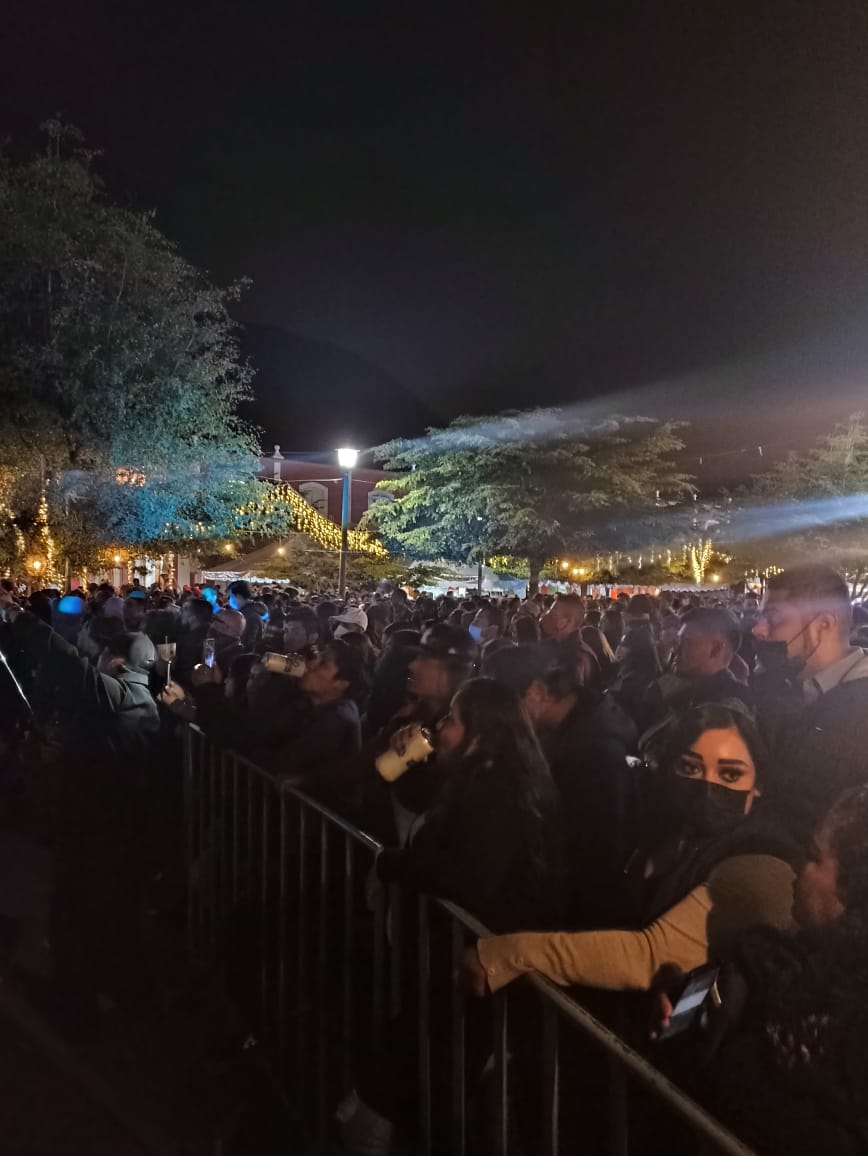
The President of Jocotepec said that it would have been worse to cancel the business generated by the festivities. Photo: Héctor Ruiz.
On Tuesday, January 11, the Civil Protection and Firefighters Unit (UPCB) of Jocotepec, in conjunction with municipal authorities, reported that at least 30 percent of the merchants did not abide by the appropriate safety measures.
«The incidents that persisted the most, where participants were given a warning to comply with the measures, was in the use of masks and antibacterial gel,» explained municipal authorities.
They also explained that skepticism regarding the use of masks and the pandemic itself was prevalent among the elderly, who are one of the segments of the population most vulnerable to the disease.
The municipal president condemned accusations against him for being negligent and irresponsible for allowing the festivities to continue. He pointed out that the municipality has taken all possible measures to safeguard the well-being of the inhabitants of Jocotepec. However, “it is the people who can voluntarily decide to respect the measures or not,” he said.
Translated by Colleen Beery and Kerry Watson
© 2016. Todos los derechos reservados. Semanario de la Ribera de Chapala

